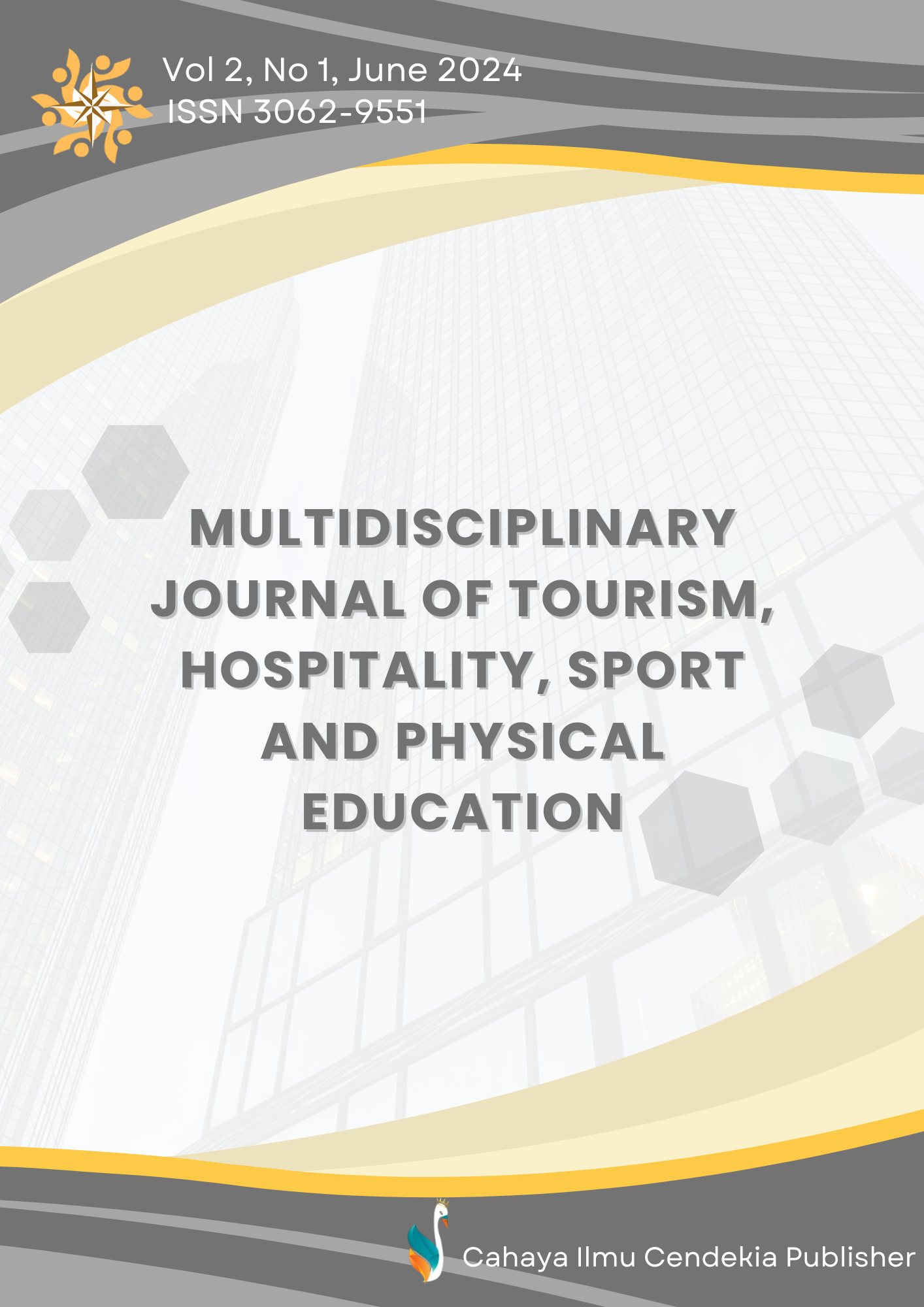The Development Benefits And Risks Of Recreational Parkour Sports In The Freerun Flow It Parkour Community
Abstract
Purpose of the study: This study aims to explore the development, benefits, and risks of parkour as a recreational sport in the Parkour Freerun Flow It community in Pekanbaru. It focuses on the community's progress, the physical and mental benefits, and the potential risks associated with the sport.
Methodology: This study used a qualitative method with purposive sampling. Data were collected through direct observation, semi-structured interviews, and documentation. The subjects consisted of community members and experts, including athletes, therapists, and medical professionals. Data analysis followed the Miles and Huberman model: data reduction, data display, and conclusion drawing.
Main Findings: The study found a decline in interest and training intensity within the parkour community due to limited training facilities and lack of institutional support. Despite this, parkour offers significant benefits such as improved physical fitness, mental resilience, and self-confidence. Risks include minor to severe injuries, particularly if warm-ups are neglected. Younger practitioners are especially vulnerable due to underdeveloped joints and bones.
Novelty/Originality of this study: This study contributes to the understanding of parkour as an emerging recreational sport in Indonesia. It uniquely documents the evolution and current state of a regional parkour community, highlighting the dual nature of parkour as both physically beneficial and potentially hazardous. It offers insights for policymakers to better support urban recreational sports.
References
Y. Guo, H. Shi, D. Yu, and P. Qiu, “Health benefits of traditional Chinese sports and physical activity for older adults: A systematic review of evidence,” J. Sport Heal. Sci., vol. 5, no. 3, pp. 270–280, 2016, doi: 10.1016/j.jshs.2016.07.002.
H. L. R. Souza et al., “Does ischemic preconditioning enhance sports performance more than placebo or no intervention? A systematic review with meta-analysis,” J. Sport Heal. Sci., vol. 14, 2025, doi: 10.1016/j.jshs.2024.101010.
A. Littleton and K. Guskiewicz, “Current concepts in sport concussion management: A multifaceted approach,” J. Sport Heal. Sci., vol. 2, no. 4, pp. 227–235, 2013, doi: 10.1016/j.jshs.2013.04.003.
Lalu and A. Muttalib, “Development of the potential establishment of the sports industry in creating business opportunities in Kuta Mandalika,” Int. J. Econ. Bus. Adm., vol. X, no. Issue 3, pp. 97–111, 2022, doi: 10.35808/ijeba/779.
J. P. Mihalik, R. C. Lynall, E. F. Teel, and K. A. Carneiro, “Concussion management in soccer,” J. Sport Heal. Sci., vol. 3, no. 4, pp. 307–313, 2014, doi: 10.1016/j.jshs.2014.07.005.
A. Timm et al., “Promoting men’s health through sports clubs: A systematic rapid realist review,” J. Sport Heal. Sci., vol. 14, p. 100969, 2024, doi: 10.1016/j.jshs.2024.100969.
M. Pengelly, K. Pumpa, D. B. Pyne, and N. Etxebarria, “Iron deficiency, supplementation, and sports performance in female athletes: A systematic review.,” J. Sport Heal. Sci., vol. 14, p. 101009, 2024, doi: 10.1016/j.jshs.2024.101009.
H. Liu, W. E. Garrett, C. T. Moorman, and B. Yu, “Injury rate, mechanism, and risk factors of hamstring strain injuries in sports: A review of the literature,” J. Sport Heal. Sci., vol. 1, no. 2, pp. 92–101, 2012, doi: 10.1016/j.jshs.2012.07.003.
L. M. Schwab Reese, R. Pittsinger, and J. Yang, “Effectiveness of psychological intervention following sport injury,” J. Sport Heal. Sci., vol. 1, no. 2, pp. 71–79, 2012, doi: 10.1016/j.jshs.2012.06.003.
M. Lochbaum and J. Gottardy, “A meta-analytic review of the approach-avoidance achievement goals and performance relationships in the sport psychology literature,” J. Sport Heal. Sci., vol. 4, no. 2, pp. 164–173, 2015, doi: 10.1016/j.jshs.2013.12.004.
R. Li, “Why women see differently from the way men see? A review of sex differences in cognition and sports,” J. Sport Heal. Sci., vol. 3, no. 3, pp. 155–162, 2014, doi: 10.1016/j.jshs.2014.03.012.
M. Lochbaum, J. Jean-Noel, C. Pinar, and T. Gilson, “A meta-analytic review of Elliot’s (1999) hierarchical model of approach and avoidance motivation in the sport, physical activity, and physical education literature,” J. Sport Heal. Sci., vol. 6, no. 1, pp. 68–80, 2017, doi: 10.1016/j.jshs.2015.07.008.
G. Sjøgaard et al., “Exercise is more than medicine: The working age population’s well-being and productivity,” J. Sport Heal. Sci., vol. 5, no. 2, pp. 159–165, 2016, doi: 10.1016/j.jshs.2016.04.004.
L. N. Erickson and M. A. Sherry, “Rehabilitation and return to sport after hamstring strain injury,” J. Sport Heal. Sci., vol. 6, no. 3, pp. 262–270, 2017, doi: 10.1016/j.jshs.2017.04.001.
M. Caru, A. Levesque, F. Lalonde, and D. Curnier, “An overview of ischemic preconditioning in exercise performance: A systematic review,” J. Sport Heal. Sci., vol. 8, no. 4, pp. 355–369, 2019, doi: 10.1016/j.jshs.2019.01.008.
A. Vlahoyiannis, G. Aphamis, G. C. Bogdanis, G. K. Sakkas, E. Andreou, and C. D. Giannaki, “Deconstructing athletes’ sleep: A systematic review of the influence of age, sex, athletic expertise, sport type, and season on sleep characteristics,” J. Sport Heal. Sci., vol. 10, no. 4, pp. 387–402, 2021, doi: 10.1016/j.jshs.2020.03.006.
C. Towlson et al., “Maturity-associated considerations for training load, injury risk, and physical performance in youth soccer: One size does not fit all,” J. Sport Heal. Sci., vol. 10, no. 4, pp. 403–412, 2021, doi: 10.1016/j.jshs.2020.09.003.
J. Pérez-Gómez, J. C. Adsuar, P. E. Alcaraz, and J. Carlos-Vivas, “Physical exercises for preventing injuries among adult male football players: A systematic review,” J. Sport Heal. Sci., vol. 11, no. 1, pp. 115–122, 2022, doi: 10.1016/j.jshs.2020.11.003.
A. Zech et al., “Sex differences in injury rates in team-sport athletes: A systematic review and meta-regression analysis,” J. Sport Heal. Sci., vol. 11, no. 1, pp. 104–114, 2022, doi: 10.1016/j.jshs.2021.04.003.
J. van Ierssel, K. F. Pennock, M. Sampson, R. Zemek, and J. G. Caron, “Which psychosocial factors are associated with return to sport following concussion? A systematic review,” J. Sport Heal. Sci., vol. 11, no. 4, pp. 438–449, 2022, doi: 10.1016/j.jshs.2022.01.001.
A. Konrad et al., “Chronic effects of stretching on range of motion with consideration of potential moderating variables: A systematic review with meta-analysis,” J. Sport Heal. Sci., vol. 13, no. 2, pp. 186–194, 2024, doi: 10.1016/j.jshs.2023.06.002.
S. Faggian et al., “Sport climbing performance determinants and functional testing methods: A systematic review,” J. Sport Heal. Sci., vol. 14, p. 100974, 2024, doi: 10.1016/j.jshs.2024.100974.
J. M. Schulz, L. Pohlod, S. Myers, J. Chung, and J. S. Thornton, “Are female athlete specific health considerations being assessed and addressed in preparticipation examinations? A scoping review and proposed framework,” J. Sport Heal. Sci., vol. 14, p. 100981, 2024, doi: 10.1016/j.jshs.2024.100981.
D. Jochum et al., “The merit of superimposed vibration for flexibility and passive stiffness: A systematic review with multilevel meta-analysis,” J. Sport Heal. Sci., vol. 14, 2025, doi: 10.1016/j.jshs.2025.101033.
J. H. Kim, K. Lee, and Y. Kim, “Ethical implications of artificial intelligence in marketing: A systematic literature review,” J. Bus. Res., vol. 134, pp. 722–735, 2021, doi: 10.1016/j.jshs.2025.101047.
R. R. Krishnan, “A knowledge network for a dynamic taxonomy of psychiatric disease,” Dialogues Clin. Neurosci., vol. 17, no. 1, pp. 79–87, 2015, doi: 10.31887/dcns.2015.17.1/rkrishnan.
R. Bertrand, H. Jonsson, I. Margot-Cattin, and B. Vrkljan, “A narrative analysis of the transition from driving to driving cessation in later life: Implications from an occupational lens,” J. Occup. Sci., vol. 28, no. 4, pp. 537–549, 2021, doi: 10.1080/14427591.2021.1879239.
T. Steimer, “Animal models of anxiety disorders in rats and mice: Some conceptual issues,” Dialogues Clin. Neurosci., vol. 13, no. 4, pp. 495–506, 2011, doi: 10.31887/dcns.2011.13.4/tsteimer.
C. W. Callaghan, “Contemporary HIV/AIDS research: Insights from knowledge management theory,” Sahara J, vol. 14, no. 1, pp. 53–63, 2017, doi: 10.1080/17290376.2017.1375426.
D. A. Adeniyi and M. F. Dinbabo, “Efficiency, food security and differentiation in small-scale irrigation agriculture: Evidence from North west Nigeria,” Cogent Soc. Sci., vol. 6, no. 1, 2020, doi: 10.1080/23311886.2020.1749508.
F. Damanik, T. Rahayu, and H. Setyawati, “The analysis of the potential of sports tourism in Simalungun regency,” J. Phys. Educ. Sport., vol. 9, no. 3, pp. 198–203, 2020, [Online]. Available: https://journal.unnes.ac.id/sju/index.php/jpes/article/view/34391
J. Mustell, S. Geidne, and D. Barker, “The transformation of ball games as pedagogic discourse within physical education teacher education,” Eur. Phys. Educ. Rev., vol. 30, no. 3, pp. 343–360, 2024, doi: 10.1177/1356336X231207485.
H. von Kürthy, K. Aranda, G. Sadlo, and G. Stew, “Embroidering as a transformative occupation,” J. Occup. Sci., vol. 30, no. 4, pp. 647–660, 2023, doi: 10.1080/14427591.2022.2104349.
S. Lovestone, “Fleshing out the amyloid cascade hypothesis: the molecular biology of Alzheimer’s disease,” Dialogues Clin. Neurosci., vol. 2, no. 2, pp. 101–110, 2000, doi: 10.31887/dcns.2000.2.2/slovestone.
R. C. Gur and R. E. Gur, “Memory in health and in schizophrenia,” Dialogues Clin. Neurosci., vol. 15, no. 4, pp. 399–410, 2013, doi: 10.31887/dcns.2013.15.4/rgur.
E. J. Crawford, E. C. Crook, L. Waldby, and P. Douglas, “New perspectives on responsive infant care: A qualitative study of the ways in which Neuroprotective Developmental Care (NDC) shapes mother-infant co-occupations,” J. Occup. Sci., vol. 31, no. 2, pp. 337–353, 2024, doi: 10.1080/14427591.2023.2236117.
W. Kurevakwesu, E. Mthethwa, K. Chirangwanda, and T. Mabeza, “Parental perceptions towards reintegration of pregnant girls and teenage mothers into the education system in Zimbabwe,” Cogent Soc. Sci., vol. 9, no. 1, 2023, doi: 10.1080/23311886.2023.2186564.
A. Tebandeke and R. Premkumar, “Political and socio-economic instability: does it have a role in the HIV/AIDS epidemic in sub-saharan Africa? case studies from selected countries,” Sahara J, vol. 8, no. 2, pp. 65–73, 2011, doi: 10.1080/17290376.2011.9724987.
R. Aldrich, D. L. Rudman, K. Fernandes, G. Nguyen, and S. Larkin, “(Re)making ‘third places’ in precarious times: Conceptual, empirical, and practical opportunities for occupational science,” J. Occup. Sci., vol. 7591, 2023, doi: 10.1080/14427591.2023.2234382.
A. Aguzzi, “Recent developments in the pathogenesis, diagnosis, and therapy of prion diseases,” Dialogues Clin. Neurosci., vol. 3, no. 1, pp. 25–36, 2001, doi: 10.31887/dcns.2001.3.1/aaguzzi.
H. Georgiou, K. Maton, and M. Sharma, “Recovering knowledge for science education research: Exploring the ‘Icarus Effect’ in student work,” Can. J. Sci. Math. Technol. Educ., vol. 14, no. 3, pp. 252–268, 2014, doi: 10.1080/14926156.2014.935526.
M. Asbjørnslett, S. R. Berg, V. Einarsdottir, and L. S. Skarpaas, “Stranded in the living room: A narrative study of occupational disruption and imbalance as experienced by two Norwegian students during the COVID-19 pandemic lockdown,” J. Occup. Sci., vol. 30, no. 2, pp. 184–195, 2023, doi: 10.1080/14427591.2023.2190344.
S. Brooks and S. Reynolds, “The exploration of becoming as a yoga practitioner and its impact on identity formation, health, and well-being,” J. Occup. Sci., vol. 31, no. 2, pp. 354–370, 2024, doi: 10.1080/14427591.2023.2253802.
B. A. Adie, A. Weighill, E. Dong, R. McGrath, H. Mair, and R. A. Mowatt, “The future of leisure studies in six landscapes,” Loisir Soc., vol. 48, no. 1, pp. 90–108, 2025, doi: 10.1080/07053436.2025.2474281.
M. Berger, E. Asaba, M. Fallahpour, and L. Farias, “The sociocultural shaping of mothers’ doing, being, becoming and belonging after returning to work,” J. Occup. Sci., vol. 29, no. 1, pp. 7–20, 2022, doi: 10.1080/14427591.2020.1845226.
L. S. Basell and E. E. Spinapolice, “Time, the middle stone sge and lithic analyses following the third Science revolution,” Azania, vol. 59, no. 1, pp. 140–159, 2024, doi: 10.1080/0067270X.2023.2285167.
R. Gorman and G. Davies, “When ‘cultures of care’ meet: entanglements and accountabilities at the intersection of animal research and patient involvement in the UK,” Soc. Cult. Geogr., vol. 24, no. 1, pp. 121–139, 2023, doi: 10.1080/14649365.2020.1814850.
Copyright (c) 2025 Claudia Salsabillah

This work is licensed under a Creative Commons Attribution 4.0 International License.
Authors who publish with this journal agree to the following terms:
- Authors retain copyright and acknowledge that the Journal of Health Innovation and Environmental Education is the first publisher licensed under a Creative Commons Attribution 4.0 International License.
- Authors are able to enter into separate, additional contractual arrangements for the non-exclusive distribution of the journal's published version of the work (e.g., post it to an institutional repository or publish it in a book), with an acknowledgment of its initial publication in this journal.
- Authors are permitted and encouraged to post their work online (e.g., in institutional repositories or on their website) prior to and during the submission process, as it can lead to productive exchanges and earlier and greater citation of published work.


.png)
.png)
.png)



